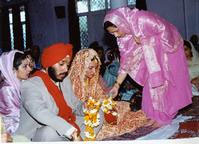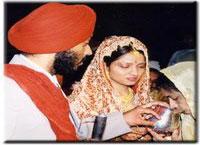THE MARRIAGE CEREMONY OF THE SIKHS

Sikhism represents more than the physical uniting of two
families or even two people. The Sri Guru Granth Sahib (the Sikh holy book),
says that marriage merges two souls.
†
AN
ideal husband and wife will be spiritually inseparable, their individual pasts
and presents combining to form one. The spiritual goal of any Sikh is to merge
his or her soul (atma) with God (Parmatma) and in marriage, the couple will help
each other towards this goal.
Pre-Wedding Rituals
As in many Asian marriages, a formal engagement takes place before the wedding. The engagement, shagan, is held either at a gurdwara (Sikh house of worship) or at
the groomís family house. Both families come together exchanging gifts and
mutual promises of marriage. The bride and groom will exchange rings. Whereas,
at this stage in many Asian weddings, a dowry agreement would be made, Sikhs
have strictly condemned dowry payments. Sikh belief is that, in the wedding
exchange, all the brideís father should offer is his daughter.

Three days before the wedding, the akhand paath and the myah ritual are begun. Both
practices last until the wedding day. Akhand paath is a three-day reading of the
Sri Guru Granth Sahib. In the myah ritual, the bride and groom are both cleansed
by their respective families each morning and night. Their hands, feet and faces
are massaged with flour, oil and tamarind powder to purify them for their
rapidly approaching married life.
On the night before the wedding, both
bride and groom will be adorned with mehndi. Mehndi, as an Asian wedding
tradition, dates back to Mughal times. The hands and feet are intricately
patterned with a paste of henna, oil, lemon juice and water steeped in tea
leaves. Mehndi is supposed to symbolise the strength of love in a marriage.
Hence the darker the designs, the stronger the love.
Following the
traditional application of mehndi, a choodha ceremony is held for the bride. An
important ceremony, the bride is made to wear 21 red and cream ivory bangles.
Kalira (ornaments) are then tied to the bangles by the brideís maternal aunt and
uncle. The purpose of kalira is to make housework impossible. The bangles and
kalira are worn throughout the wedding ceremony and for 40 days afterwards.
Unlike certain Hindu rituals where the bride is asked to cook for her new family
as soon as she enters the house, Sikh brides are given time to acclimatise to
their new families.
The Wedding Day
On the wedding day, both bride and groom are readied in their respective homes. In the nath ritual, the brideís maternal uncle places a traditional nose ring on her. The nose ring compliments her salwar-kameez, dupatta and jewellery. The groom may wear Punjabi or western dress provided his outfit maintains, as always, the 5 Ks of
traditional Sikh dress: Kangha (comb), Kesh (hair, unshorn), Kaccha (shorts),
Kirpan (sabre) and Kara (bracelet).
The wedding day is begun at the gurdwara with the morning hymns (asa di var) prior to either of the wedding partiesí arrivals. As both families and the groom arrive, hymns specifically for them are sung. Once everyone, excluding the bride, has arrived, a milnee is
held. In the milnee, both familiesí exchange presents, tacitly accepting one
another.
The Wedding Ceremony
The Sikh wedding ceremony, anand
karaj, is performed at a gurdwara by a Sikh minister. Anand karaj literally
means the 'ceremony of bliss'. The ceremony starts with kirtan- the singing of
hymns by the ragis (musicians).
What follows may happen in one of two
ways. The groom and bride may either be seated with the congregation (sadh
sangat) and be invited by the minister to come and sit in front of the Guru
Granth Sahib. Or, the groom may be seated first in front of the holy book and
the bride led in afterward escorted, usually, by her mother and best friend.
Tradition dictates that the bride sit to the groomís left. The minister
will then explain the Sikh perspective (above) of marriage, stressing the
importance of the union about to take place.
After the ministerís
address, the ceremonial procedures truly begin. The couple and their parents
stand and ardas (prayers) are spoken asking for Godís blessing for the proposed
marriage and the couple.
These opening prayers are followed by the palaa
ceremony. A shawl, normally pink or saffron-coloured, is folded lengthwise. The
right end is placed over the groomís shoulder and into his hands; the bride
holds the left end. Throughout the palaa ceremony, the ragis sing a prayer, the
Shabad Palai. Palaa, similar to other Asian wedding traditions, bonds the couple
together physically to represent their spiritual link.
What follows is
critical and special to Sikh marriages. The Laavan, written by the fourth guru,
Guru Ram Das for his own marriage, is a series of four prayers. Literally Laavan
means 'break away'- the marriage is the bride breaking away from her natural
family.
The couple stand and the first prayer is spoken by the minister
in Gurmukhi first and then translated into English if necessary. The ragis sing
his words as the couple walks, connected by the palaa, clockwise around the Guru
Granth Sahib. The groom leads the bride during the circling of the Guru Granth
Sahib. They finish their round as the ragis finish the prayer. The couple then
bows to the holy book and sits waiting the second prayer of the Laavan. Each
round is performed in the same manner.
The Laavan serves a dual purpose:
the verses are both offerings of advice and references to times of married life.
The first verse impresses upon the importance of committing oneself to
righteousness, communication with oneís own soul and the spiritual journey of
all Sikhs.
The second verse tells the couple of their future success. In
marrying, they will find the true Guru; they can move beyond their own
personalities and prejudices, using the marital institution as part of their
spiritual paths.
The third verse says that the couple is blessed to be
part of a supportive Sikh community and that to follow the spiritual path set
before them, they should serve and respect those around them. The final verse of
the Laavan says that in marriage the two will inspire each other towards
becoming one with the Infinite, as they follow the advice of the previous three
verses.
At the completion of Laavan, the assembly showers the couple with
flower petals. According to Sikh codes of conduct, the two are now officially
married. The minister will then say a few words to close the ceremony and
legally pronounce the couple as husband and wife.
The newly joined
couple simultaneously feeds each other fruit, a first act of marriage. The
traditional Sikh 'song of bliss' will be sung followed by ardas for the entire
assembly. The wedding ceremony ends with the distribution of guruprashad
(blessed food) to the attendees.
|



